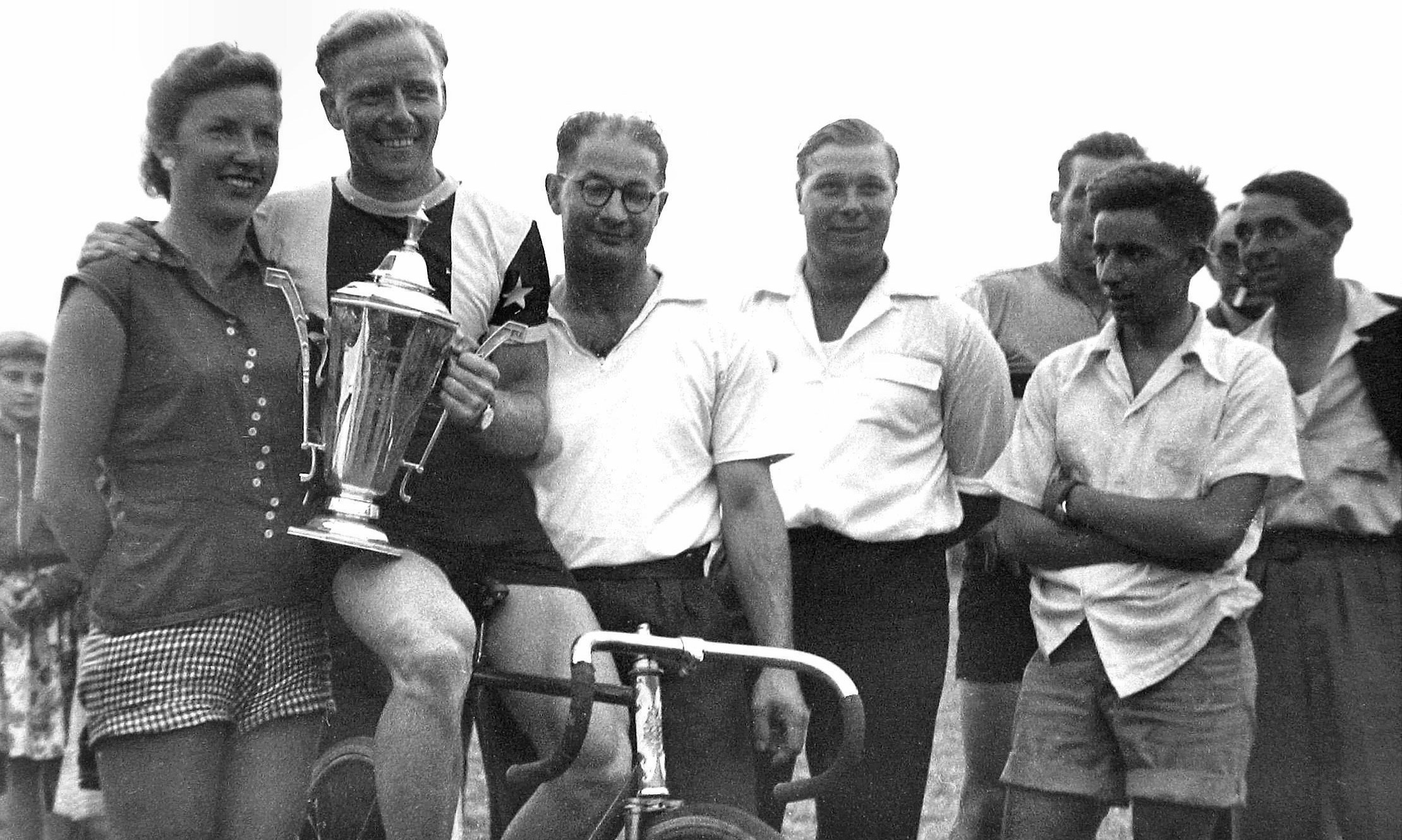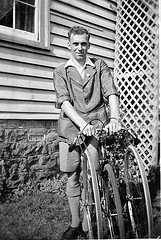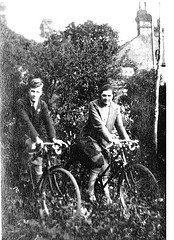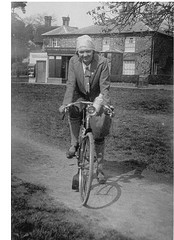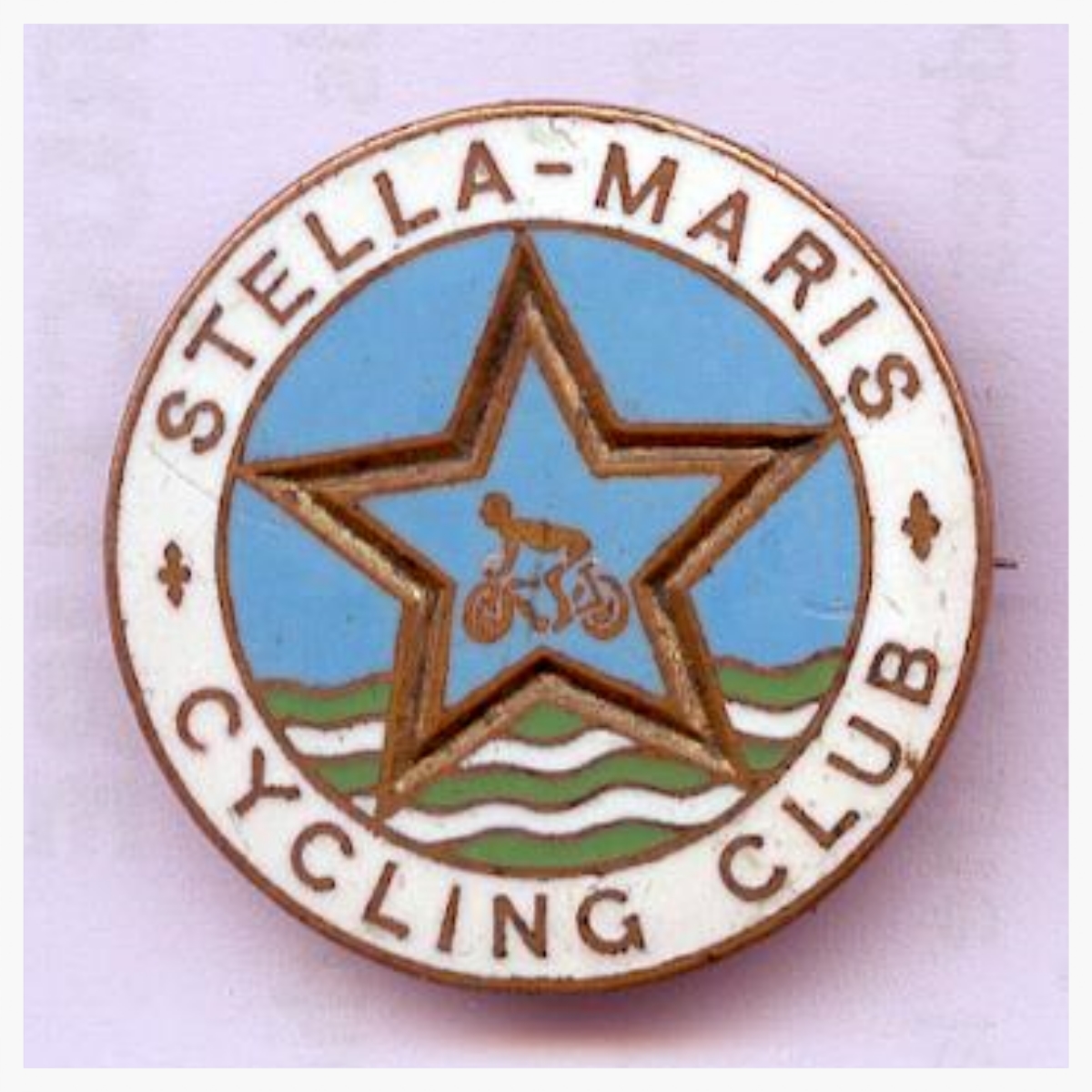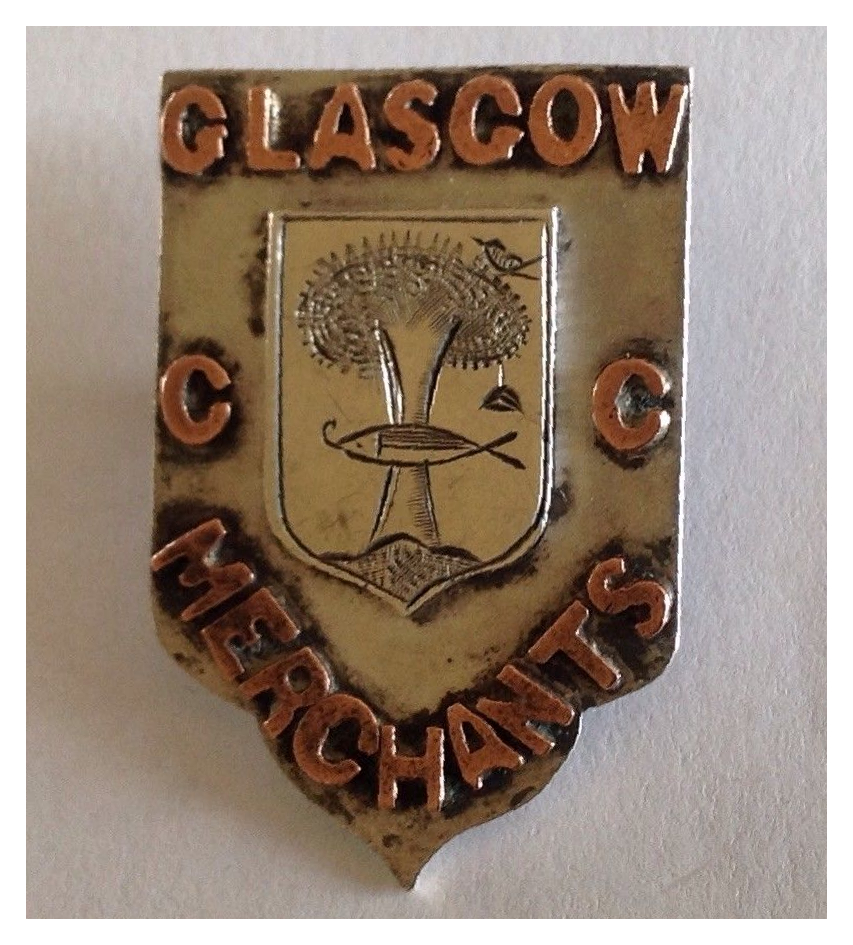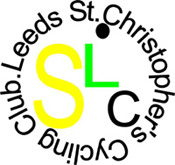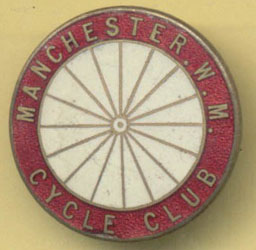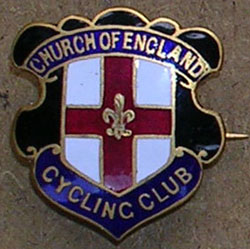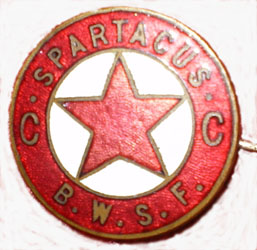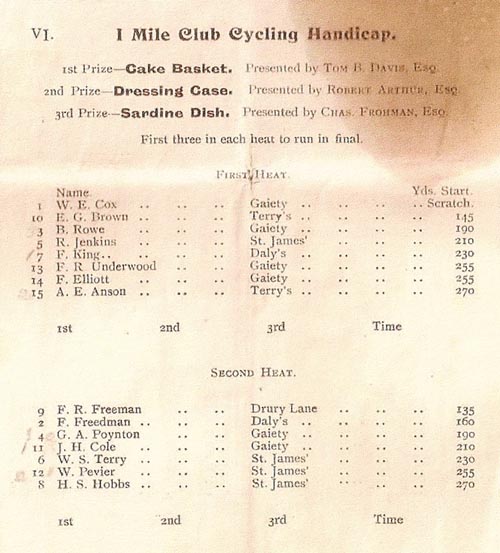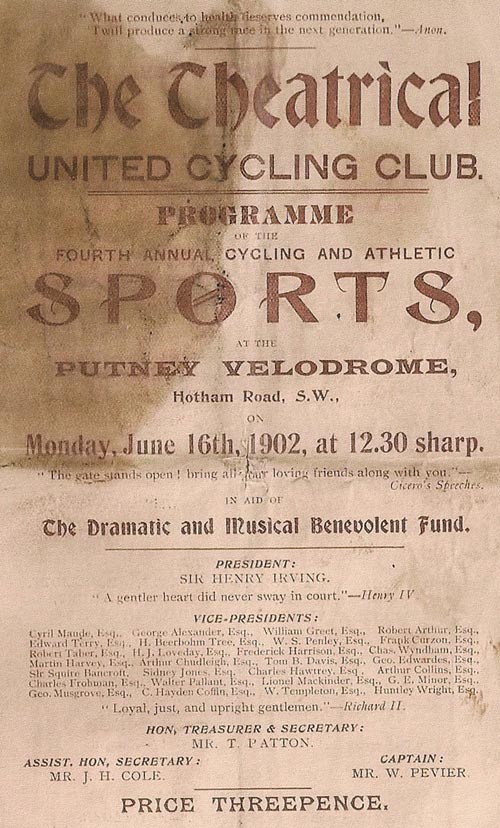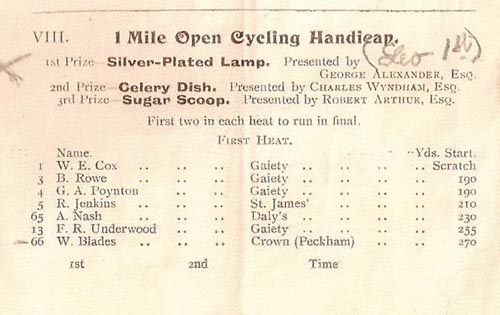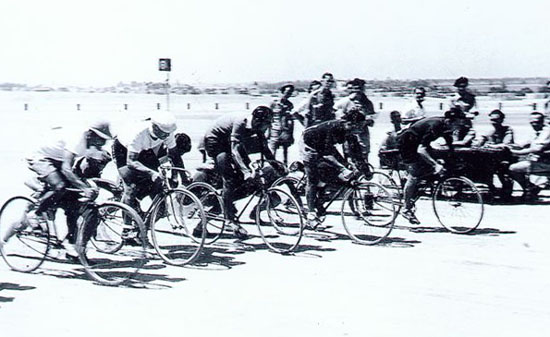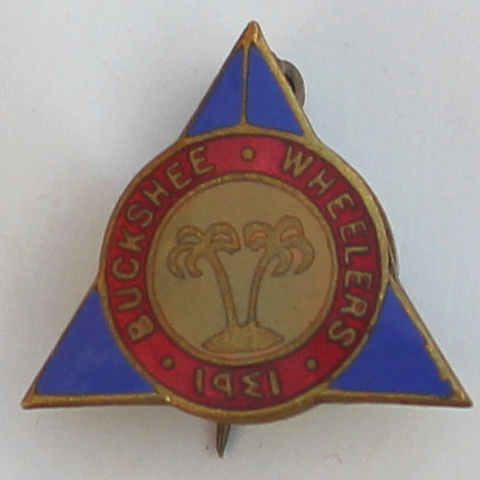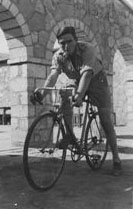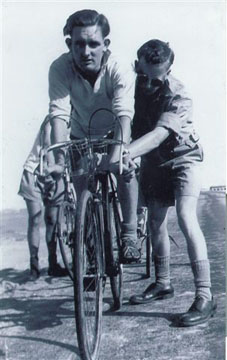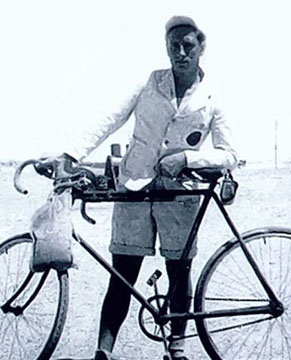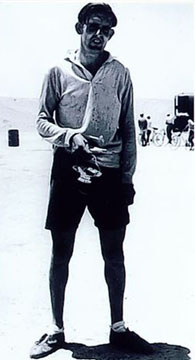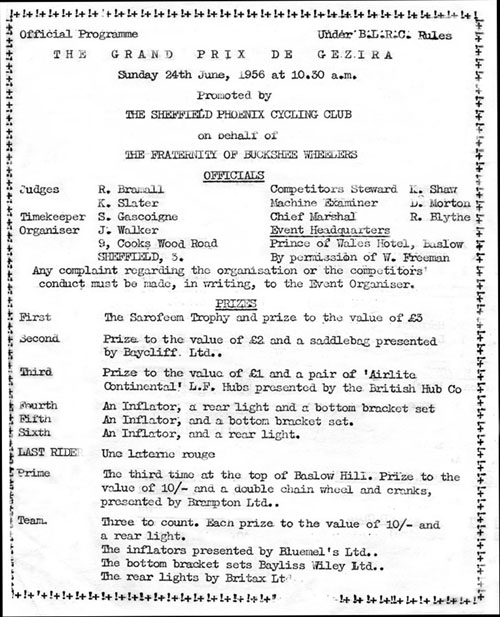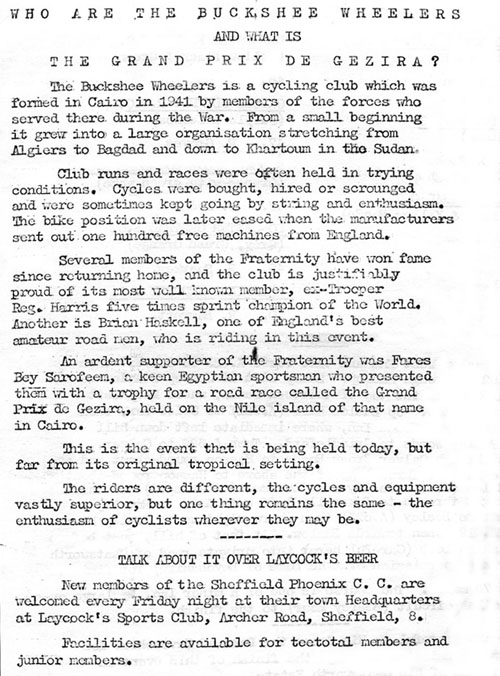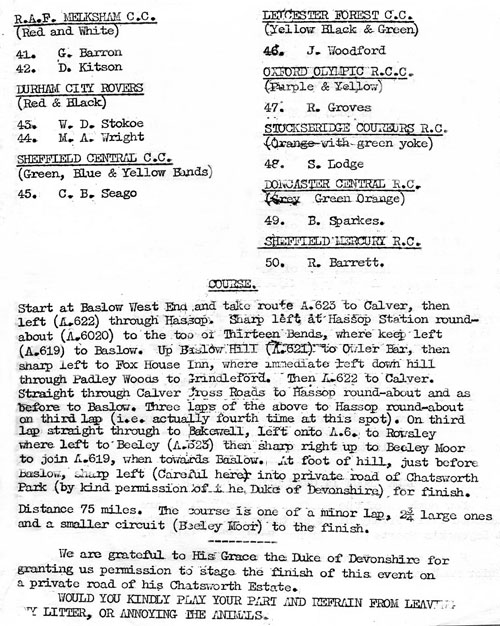Speciality Cycling Clubs from the Classic Era
Posted: Saturday 22nd August 2020
I am still looking for information on specialised clubs which were around in the 1930’s, 40’s and 50’s and would be grateful for any material relating to them. As well as the clubs listed, there were Police clubs, Railway clubs, large company clubs and maybe even a club for Lyons Corner House Nippies and Showgirls from the theatres in London. They certainly ran events for both at Herne Hill track events and they competed on proper track bikes – they weren’t ‘novelty’ races ridden on shopping and town bikes, as one may expect. “Co-operative” clubs also existed such as the Middlesborough Co-operative CC.
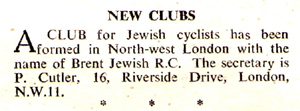
Brent Jewish Road Club
Was listed in the North London Section of the BLRC Handbook in 1951 says Bernard Howard. Nothing more known at present – do you know anything about this club? This is the third religious club, Catholic, and a badge of Church of England C C below.
The National Clarion Cycling Club
The Clarion Cycling Club was formed in 1895 after a group of like-minded individuals got together in Birmingham in 1894. It took the Clarion name from Robert Blatchford’s socialist newspaper.
The National Clarion Cycling Club grew during the early 1900’s with 8,000+ members at one time and with sections all over the UK. Working class people were getting their freedom on bikes in the countryside and the Clarion was spreading the word and the newspaper to industrial towns and villages. In those days before most people could own a car, the bike gave freedom and fellowship … the Clarion thrived. It survives to this day. Their current web site states:
“We now have some 806 members in 25 sections, which makes us one of the bigger cycling clubs in the country. Bikes still give us our freedom, freedom from the motorcar, the stresses of the rat-race and gives us great friendship, great friends around the country.
Whether we race, socialise, tour or meet in cafes, the Clarion is a CLUB, a true club not an association.”

Sunday night debates in the Clarion Cafe on Market Street, Manchester, were a favourite meeting place for Trotskyists, ILP members, Socialists, Communists and other assorted Leftists.
In the late nineteenth and early twentieth centuries the National Clarion Cycling Club and the Clarion Movement more generally established a number of residential club-houses in rural areas which offered both accommodation and refreshments to Clarion members and others. The last of these, Chevin End near Otley in Yorkshire, closed in 2010. Other socialist organisations, such as the Independent Labour Party (ILP), also opened rural tea-rooms during the period the Clarion was opening its club-houses and these were often called, formally or informally, Clarion Houses. The Clarion House belonging to the Nelson ILP, located in Roughlee Booth in Lancashire, is still functioning. Only open on Sundays . . .
This last paragraph from Melvyn Hirst whose Clarion clubhouses website is at: http://clarionclubhouses.cambrianmoons.com/
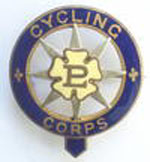
Primrose League Cycling Corps
In 1883, at The Carlton Club, Randolph Churchill (father of Winston) was instrumental in forming The Primrose League to promote the cause of Conservatism (with capital ‘C’) and to bang the patriotic and Empire drums. The motto of the League was ‘Imperium et Libertas’ which was incorporated into some of the league’s badges. The Primrose League Cycling Corps (see badge left) was established with The Rt Hon. A J Balfour as President.
Primrose League clubs were also created for many sports and interests other than cycling with the idea of spreading ‘the message’ amongst both youth and lower classes which would not normally be so influenced. A special section was created for children known as the Primrose Buds. As they grew older they would progress to the Beaconsfield Branches of the Primrose League, with own badge, until old enough to join the adult organisation. The league also held many social events and public meetings throughout the country and at its peak had over a million members. As the new millenium approached, numbers were dwindling and eventually in 2004 it was disbanded with the remaining funds (some £70,000) handed over to the Conservative party.
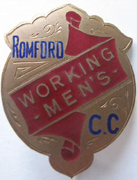
Romford Working Men’s CC
Many towns would have ‘social/political’ clubs such as the Conservative Club, The Labour Club, The British Legion and in towns with a manufacturing base such as Romford, The Working Men’s Club.
I am assuming that this badge refers to the cycling section run as part of a working men’s institution. Although we know cyclists who have connections with Romford, none are aware of this particular club.
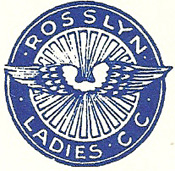
Rosslyn Ladies
In 1922 many male-dominated clubs banned women riders from their ranks. Consequently a group of women set about forming a ‘Ladies’ club where they would be able to organise rides, time trials, track racing and social events for their members. The first President was Lady (what better title?) de Freece who was known in the music halls as Vesta Tilley – not a shrinking violet. In 1927 they organised their first track events for women and these were followed shortly afterwards by time-trials, amongst the first of which was a marathon 12-hour event. Along with several male clubs the Rosslyn Ladies built a bungalow-style club house in the Newport-Elsenham area conveniently close to the start of several time trials held on the nearby A11. The club still exists and organises rides and social events for its small band of members.
The tradition carries on with the development of a number of cycling clubs for women across the UK including the formation in 2008 of The No. 1 Muslim Ladies Cycling Club at a Mosque in East London by an ex-student of Cambridge University.
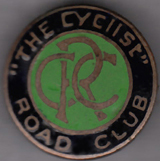
The Cyclist” Road Club
An unusual club this which was formed for readers of The Cyclist, a weekly magazine, which was founded 1936 giving free insurance and touring in exchange for an annual subscription. It also offered free technical and touring advice plus the right to compete in races organised by the CRC. The Cyclist was published by George Newnes a fierce publishing rival to the Temple Press (Cycling). Its first editor was F.J.Camm author of Every Cyclists Handbook. George Newnes started his publishing career in 1881 with Titbits. He funded the magazine by opening a vegetarian restaurant in Manchester. He also owned The Strand famous for first publishing the Sherlock Holmes stories. Country Life was also one of his many publications. He is alsoy remembered as the driving force in thr opening of the Lynton to Barnstable narrow gauge railway.
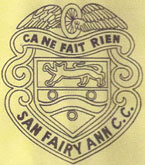
The San Fairy Ann CC
A church club formed in the early 1920’s for the benefit of service-men recently returned from WWI.
Mike Baker explains: I joined the San Fairy Ann around 1957 when I was 14, and stayed with them for around 30 years, thereby becoming known in Kentish cycling circles as a “Fairy”.
The Westborough Congregational Church Cycling Club (Maidstone) was formed in the twenties by founders of the church to provide facilities for ex-servicemen who had recently returned from fighting in World War I and so the majority of the first members enrolled had recently returned from the gruelling conditions of the 1914-18 war. The club held runs on Saturdays and Wednesdays only as they would not countenance cycling on Sundays because of their strict religious beliefs. The first activities of the Westborough club were club runs on Saturday afternoons and Wednesday evenings, with the first races being club time trials in 1924.
Because of the ban on Sunday runs, at a time when many working men were employed on a six day week, most of the ex-service founders left after a few years to form another club at a meeting held at the Anchor Inn at Yalding. There was some difficulty in deciding a name for the club, and the soldiers’ slang, “San Fairy Ann” (Ca ne fait rien) for “It doesn’t matter” was chosen. The French and English mottos appear on the club badge together, with the Maidstone town arms. The SFA was one of the founder members of the Kent Cycling Association in 1928 and enjoyed considerable success in both individual and team championships. The club’s current Mens’ Best All-rounder trophy was originally a KCA team trophy that SFA members won outright in the early days.
Arthur Goodhugh kept the Saturday runs going during World War 2, continuing to meet post war at South Park Road, Maidstone, a favourite tea stop being Southborough Wheelers idyllic rural clubroom at Hildenborough, where they regaled us with superb homemade teas. One engaging character was club BAR Frank Ford, who, before every clubrun, would light up a very thin rollup and keep it going for the duration of the ride, much to the amusement of us youngsters!
In the late 50s the Fairies held a run from Maidstone to Herne Hill track on Good Fridays, a round trip of about 60 miles, invariably completed on a single fixed gear of 72 inches. Parking at the Hill was a nightmare, as was finding your bike afterwards, as thousands of machines were stacked against the perimeter fence, 10 deep. However, the return trip on traffic free roads was magical, and a happy memory which I still cherish. Looking back up Wrotham Hill one could see a long line of Kentish cyclists descending in the dark, hundreds of front lamps twinkling in the gloom. We shall never see the like again.
Similarly, on Whit Monday, there was a trip to the grass track at Faversham, climbing Hollingbourne Hill, one of the steepest cols in the North Downs, again on a single fixed, cape stowed behind the saddle in the obligatory Walls ice cream poster, or, for the very lucky ones, Lyons Maid. On reaching the track, the competitors would discard mudguards, saddlebag, front brake, and reverse the rear wheel for a track sprocket before setting off on a practice lap. After a hotly contested event- no quarter given in grass track events!- the club would wait impatiently whilst the machines were reassembled, then debate how to get the prizes back to Maidstone by bike. Silver trays were easy, but china teasets posed a problem.
Clubruns are still held on Saturdays and Sundays, with up to 100 riders of various levels in 7 groups on a Saturday. During the 1960s and 70s, the clubroom was the cellar of Nora and Pete( 100 this year) Avis, and the club continues to meet every Tuesday night.
Time trialling has always been strong, especially in the Kent C.A. Ladies’ and Mens’ Championships, Roy Manser finished 6th and 13th in the BBAR in the 60s and jointly held the national 10 mile tandem record. Carole Gandy was Womans’ BBAR, won the national 100 mile championship, and holds several joint tandem records with Geoff Hodgson. Ian Silvester won the national 12 hour championships promoted by the Fairies, and Roly Crayford has 3 golds in the Worlds Masters track championships.
Promising youngsters are junior MTB champion Katherine Hibberd, and roadman Ian Field. However, despite racing successes, and being the biggest club in Kent with 400 members, including members now living in the Midlands, the Fairies are still a community club, promoting many events in all disciplines, including the annual Maidstone Fun Bike Day, Easyrider runs for novices, and Go Ride sessions for children as young as 5.
In 2007, the visit of the Tour de France to Kent saw the Fairies involved with the media in promoting the event and cycling. One stalwart who deserves mention is Pat Hill who regularly produces a monthly magazine “The Milestone” which would be the envy of most clubs. The Fairies are 90 in March 2012, and, with a dedicated band of club officials and a thriving membership, a further 90 years are confidently predicted!
Mike Baker, Bromsgrove, Jan. 2011. With permission to use material and images from S F A C C
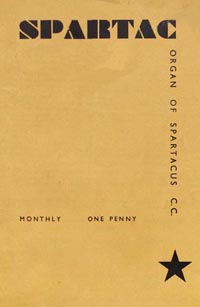
Spartacus CC
Spartacus was another specialist club, this time for card-holding members of the Communist Party (Spartacus led the slaves revolt in Roman times). The March, 1936 newsletter describes a schism within the club at the AGM where the Eastern Section defected en-masse to the Clarion which was another left-leaning club, but not quite as far to the left as the Spartacus would have been.
It also has an interesting extract from The Bicycle Ed.2 stating: “That the acute shortage in 531 tubing now being felt by small makers and their customers, is entirely due to the abnormal demands made on the manufacturers by this government’s new ‘Air Building’ programme.” The communists at this time were advocating a pacifist agenda. Note: see below for image of Mick Butler’s Spartacus CC badge.
St Christopher and other religious cycling clubs
These were formed through churches for members of the Catholic faith although the few that survive now allow members of all faiths to join them. Surviving clubs include Glasgow St Christopher’s, which recently celebrated 75 years since its formation in 1935, Leeds St Christophers CC formed in 1938 and Manchester St Christopher’s Catholic Cycling Club.
The Stella Maris club (Glasgow) was mainly Catholic and became the VC Stella before it closed and the main members joined the Glasgow Ivy.
Enquiries about another matter brought up:
- St Michael & All Angels Cycling Cub, attached to an Anglican church in Walthamstow
- St George’s Gravesend Cycle Club affiliated to St George’s Parish Church, Gravesend (Church of England) early 1900’s. The club held dances, whist drives and concerts in the nearby Church House. They also held outdoor cycle gymkhanas at Southfleet, where the prizes (given by church and club members) were presented by the curate.
- Another Glasgow club, but not necessarily Catholic, was Glasgow Merchants who had a distinctive well-crafted badge..
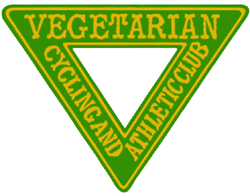
Vegetarian Cycling and Athletic Club
The Vegetarian Cycling & Athletic Club can trace its origins back to 1887, the year of Queen Victoria’s Golden Jubilee. In September of that year Leslie Large of Lewisham, an enthusiastic worker in the Vegetarian movement and a keen cyclist, placed notices in a number of periodicals inviting other Vegetarian cyclists to contact him with a view to forming a Vegetarian Cyclists’ Club. Their objective was to provide a means of contact between Vegetarian cycling enthusiasts and to seek to prove, by the yardstick of athletic competition, that Vegetarians could easily hold their own against their meat-eating counterparts.
Throughout the Spring and Summer of 1888 a series of club runs and social events were held and the membership built up steadily until over 100 names were on the roll. The first formal meeting was held on October 9th, 1888, at the Central Vegetarian Restaurant, St. Bride Street, London and this was followed by a meeting on February 9th, 1889 at the Appletree Vegetarian Restaurant, 34 London Wall, when Leslie Large was elected as the first Secretary and Arnold F. Hills, a wealthy industrialist, became the first President. The name of the Club was confirmed as the Vegetarian Cycling Club. Reports from those early days are few but it is evident that VCC racing cyclists performed competently if not outstandingly.
Henry Light, a founder member who was elected Captain in 1890, soon became the main driving force behind the Club and under his direction standards of performance of the VCC men improved steadily. 1896 saw the VCC achieve its first outstanding success when Jim Parsley of Peckham won the prestigious Catford Hill Climb, the country’s top event, in record time. The VCC were cock-a-hoop at this major breakthrough and held a dinner in Parsley’s honour.
In 1896 the green and gold triangular badge was introduced. Sadly, the same year, Leslie Large while on a visit to Edinburgh died of diptheria just as his dreams were becoming a reality. In the mid-to-late 1890’s the VCC cyclists really began to make their mark on both road and path. The riders such as the Nickel brothers, Wherlow, Sharp, Bryning, Wyatt, Parker, Walker, Newman and the Pfleiderer family achieved performances well beyond previous Club standards.
In the early years of this century the club went from strength to strength and was well organised socially. The club won several best attendance awards at Cyclists’ Rallies; a flourishing ladies branch started its own active programme. Cyclist’s such as Ragan, Ratcliffe, Newman, Agnew, Paul, Newall, Pulman, Beurle, Pearce, Gibben, Heath, Carpender, Jarratt and Briault ensured that the Club’s name figured prominently in the results list, whilst up in Scotland the redoubtable Jock Miller rallied his Vegetarian cronies to form an active Scottish branch.
As a result of the increase in athletic activities, the Club’s name was changed in 1909 to the Vegetarian Cycling & Athletic Club. In 1910 its cyclists adopted the white sleeve stripe to facilitate identification for feeding purposes. The 1912 Olympic Road Race held at Stockholm saw six Club members selected as representatives; three in the English team, two in the Scottish and one in the Irish. With the outbreak of the War in 1914 virtually every able bodied man was either coerced or conscripted “to serve King and Country”. The Club was kept going on a social basis throughout the war years but no athletic activities were carried out.
Following the armistice in 1918 the Club was slow to get into its stride again. Charlie Davy carried the Vegetarian flag virtually alone, winning events and breaking records and was selected twice as a World Championship representative. Davey turned professional in 1923 and broke several RRA records but his main goal, Land’s End to John O’Groats, eluded him, beaten by adverse weather conditions. In later years Charlie became much valued as manager and mentor to a number of successful professional and amateur riders when his experience was put to good use.
By the late 20’s the Club had quite a few promising racing cyclists coming along. Charlie Marshall, H.T.G.Page, Len Cave, Harry and Sid Ferris, Ted and Bert Brumell, George Philips, Alf Oxbrow and Sid Eaden were all capable of national performances. Marshall, Cave, the Ferris’s, Philips and Oxbrow all held RRA records at one time. Bill Ellis and E.J.Doubleday dominated the 24-hour scene. In 1930 the magazine “Cycling” introduced the “Best All Rounder” competition based on the performances at 50 miles, 100 miles and 12 hours which was to give road sport a tremendous boost. It was fortuitous that the VC & AC had at that time half a dozen of the best riders in the country at its disposal.
The club won the Best All Rounder Shield in 1930, 31 and 32 and the club’s name was rarely out of the prize list in all the major events. The impact of these successes on the cycling world was tremendous and new members entered its ranks in a steady stream. Branches were formed in Lancashire, Yorkshire, the Midlands and later in Scotland.
Sid Ferris, after an outstanding career as an amateur during which he won the classic North Road “24” three times, turned professional in 1936 and in 1937 and 1938 broke a number of RRA records including the Edinburgh to London, the Land’s End to John O’Groats and the 1,000 miles. Sid also gained the 24-hour record with 465.75 miles. Pearl Wellington, that diminutive powerhouse saw to it that the fair sex were not kept out of the picture and took track racing, time trialling and record breaking in her stride. She broke 5 WRRA records between 1935 and 1938.
Walter Greaves a one-armed member of the Yorkshire Branch set up a year’s mileage record of 45,385.75 miles and Law Innes and Bill Thompson also of the Yorkshire Branch broke a number of tandem RRA records culminating in the Land’s End to John O’Groats in 1938. The 1930s can truly be said to have been the Vegetarian C. & A.C.’s heyday. They dominated the Cycling scene in virtually every sphere. We were particularly prominent in the 12-hour, 24-hour events and one correspondent felt compelled to write to the Cycling press suggesting that Vegetarians should be banned from long distance events since their diet gave them an unfair advantage!
The clouds of World War II gathered and riders like Henry Pickersgill, Frank Hill, George Logan, Harry Rosenberg, Arthur Laston, Ted Valey, Geoff Guy, Paul Rohr, Eric Wilkinson and B.F.C. Gough ensured that the Club’s name was rarely out of the headlines.
The end of the war in 1945 found the club in a debilitated condition. It had no top rider and no one of the calibre of Henry Light to stir the club into action. Around this time the club was dealt a severe blow when the RTTC felt compelled to impose the “first claim only in open events” rule. Second claim members could, prior to this, have ridden in the club’s name but were now no longer allowed to do so.
Things were at a low ebb until 1947 when Dave Keeler made his debut and the club had a new superstar. During that year Dave quickly established himself as a top short distance rider and in a brilliant 20-year career he developed into one of the greatest all rounders, taking titles from 4,000 metres on the track to the End to End record.
Subsequently no one has matched Keeler’s efforts, though Malcolm Amey produced many superb performances in the 1960’s and took a top BBAR position. Graham West, a second claim member, was National 50 mile Champion and like Amey finished in the top 10 of the BBAR Competition. Graham currently holds all thecClub single bicycle records with the exception of Keeler’s 24-hour record which came so near to being the first ever over 500 miles. Tom Smith was another rider to achieve a top 10 BBAR placing.
The club organised annual open time trials in the 1990s thanks to Steve Oxbrow and later Nick Guy. Nick himself was very competitive alongwith Tim Holmes, Phil Packwood and later Steve Wigglesworth. Steve in particular led the way into the millennium with some winning performances in local events for the Club and not far behind was Matthew Smith. Steve & Nick also combined in the tandem with notable success. Similarly Steve and Emma Smith were successful as a mixed tandem team. Chris Stuttard was a competitive performer on the track and road racing.
Compiled by P Simpson of the V C & A C
John Gills and David Hibberd of the Veteran-Cycle Club researched this list of cycling clubs with political, religious or trade connections from the Cycling Manual 1933
It does show the depth and variety of clubs formed in these inter-war years, it includes religious, political and temperance societies of all persuasions as well as work-related clubs and one or two esoteric gatherings.
Aero Lady-back Tandem Club (London SE4) Pre-WWI there existed a Southern Ladyback Tandem CC in the same area. Presumably ‘Aero’ was added later.
Alfred Herbert CC (Coventry works club)
Bedford Wesley Guild CC (Manchester?)
Benwell Temperance CC (Newcastle)
Burnley United Temperance CC
Cestrian Imperial Ramblers CC (Durham) As ‘Cestrian’ means ‘from Chester’, this club was presumably for exiles of that city.
Darnell-Three-in-Hand CC (Sheffield)
East Wolverhampton Div. Labour Party League of Youth CC. (Contender for longest club name.)
Essex Primrose CC (London E6) Conservatives see above: Primrose League Cycling Corps.
Glasgow Corporation Transport CC
Liverpool Municipal Technical Students Assoc. CC
London General Omnibus Co. CC (London SW19)
Metropolitan Railway CC (London EC2)
Pelsall Brotherhood CC (Staffs)
Railway Clearing House CC (London NW1)
Salford Police & Fire Brigade Ath. Assoc.
Shelton Iron & Steel Co. Welfare Society CC (Birmingham)
Small Heath Weslyan CC (Birmingham)
Somercotes Rogues CC (Derby)
Stepney Templars CC (London E2)
Terpsichorean Wheelers (Rotherham) This relates to dancing.
Many thanks to John and David for this fascinating snapshot of the Thirties cycling scene
Gallery of badges from speciality clubs – supplied by Mick Butler
Also from Mick regarding speciality cycling clubs. Here are just a few from the classic era post 1936 through to the 1960’s.
Aerodyne Cycling & Social Club Aerodyne manufactured wirelesses in Tottenham, North London until the 1960’s. They mostly rode GA bikes and George Brooks made a good living from the wireless works when he was shop manager at GA’s.
Civil Service Cycling Club
Easington Colliery Unity Wheelers
Liverpool Co-Operative Society C.C.
There were also Masonic Cycling clubs Manchester, Liverpool and Paisley being three that I have seen badges for.
Norwood Paragon started life as the Norwood Postal CC in 1904, I did have an original badge but I sold it not so long ago.
There was a F. Grubb C.C. in the 1920’s?
The General Strike of 1926 started when printers on the Daily Mail refused to print an article condemning the striking miners. Most of the chapel members had been out on a cycling club run before going into work that night, not sure but it might have been the Daily Mail Cycling Club.
Other clubs include:
Cycling Templars Club – Michael Townsend writes: This was founded in the 1938 season as a club affiliated to the International Order of Good Templars. The Good Templars was (and indeed still is) a movement founded initially in the USA but now based in Sweden to promote Temperance. The cycling club may well have operated rather like the Clarions on a regional basis. You already have reference to the Stepney Templars CC above. The article from The Cyclist 10 May 1939 edition says:
“The Cycling Templars Club, which was formed last season, has started this season with success in Liverpool. The International Order of Good Templars, with which it is associated, will welcome any cyclist who is interested in our cause. Further details from G.A.V. Phillips, 35 Hudleston Road, Liverpool, 15”.
Domestic Cycling Club – “Because she felt lonely and found it difficult to make friends, a servant girl decided to take up cycling. She got into touch with other girls who also felt lonely through The Cyclist, and so the Domestic Cycling Club has now come into being. The club now has members all over the country, possesses an album containing photographs of every member, and runs its own club magazine. The young girl’s name is Miss M Leigh of Shoppenhangers Manor, Maidenhead, and she is the secretary of the club.” Spotted in The Cyclist – 26 April 1939 by Michael Townsend who thinks that the club may have been short-lived as many serving girls would have switched to munitions, or the services, shortly after the outbreak of war for probably double the wages they received in service.
Ericsson Wheelers – Ericssons were an electronics company based in Nottingham and became absorbed eventually into one of the multi-national conglomerates. Ray Booty (he of ‘first to beat 4-hours for 100-mile time trial fame’) worked for Ericsson and rode for the Wheelers. He went on to ride for the Army C U when he was conscripted in the 1950’s.
Gaiety Cycling Club
This club was most certainly in existence in 1887 and was still going strong in 1902. Now most of us have heard of the Gaiety Girls and the Stage Door Johnnies who pursued them around London in this period but how many of us have ever heard of the Gaiety Cycling Club? This club was formed of members of staff from the Gaiety Theatre. The Gaiety was located at Aldwych at the eastern end of The Strand in London.
Amongst its membership was Gertie Miller later the Countess of Dudley and Edmund Payne the famous comedian but the clubs most famous cyclist was Maggie Foster who worked on the management staff of the theatre. Maggie was amongst the first women to get her rides timed by a R.R.A timekeeper. She was possibly the best women cyclists of her time but unfortunately all her rides were paced so comparisons with later women racers and modern records are difficult. Here are some of her rides; she covered 50 miles on southern roads in 2h 14m 2s, which beat the then women’s record by 24m 16s and Leon Meredith’s S.R.R.A unpaced record by 7m 40s. Famous as Maggie Foster was for her road riding some of it done behind a Bat motorbike. These motorcycles were made by Samuel Batson in Penge but her best paced ride was done on the track.

At Crystal Palace track on October 24th 1902, behind a pacing cycle ridden by Arthur Chase she covered 30 miles 1.690 yards in an hour. This was a phenomenal ride done late in the year and with practically no experience of paced track racing behind motorbikes. The first hour record behind a motorcycle was set at 34 miles by Harry Elkes of the USA in 1898 and if we compare the equivalent British records and rides of the period; J.W.Stocks 32 miles 10-86 yards behind the Dunlop pacing quints on 27th September 1897 or Chases 37 miles 196 yards unofficial private test behind a motorcycle at Crystal Palace in July 1900 we can see that Maggie Foster was an amazing rider of this era. To think this ride took place 109 years ago and by a women cyclist is phenomenal and so little is known about her. Any information on Maggie Foster or the Gaiety Cycling club would greatly be appreciated. (Mick Butler)
Since writing this I have been told that Ellaine Terriss the Edwardian actress who was involved in the Humber Beeston advertising campaign was also a member of the Gaiety CC.
Post Office had a number of very active Sports and Social Clubs, many would have had cycling sections.
The Theatrical United Cycling Club – Roger Stevens has a programme of events of a race meeting run by this club dated 16-06-1902. Click on thumbnails below to see a selection of the pages:
Thanks to Roger, more pages can be viewed on the combined National Cycle Museum/Veteran-Cycle Club Library site at: http://www.cyclemuseum.org.uk/library/
YHA – Many of the local Youth Hostel Association groups, although rambling based, had cycling sections usually linked to hostelling weekends.
Armed-service related cycling clubs
The Exiles CC, RAF Egypt
John Basel relates:- The RAF (Egypt) CA was the governing body for ALL cycling clubs in the Canal Zone, even the Army. The RAF had a much more ‘permanent’ set-up out there than the Army, although the Army had more chaps there. So the RAF (E) CA looked after everyone. At any one time there were something like 80 to 100 active (i.e. racing) cyclists. There were about fifteen clubs all told. Ours, the Exiles CC, was the best (I would say that wouldn’t I!).
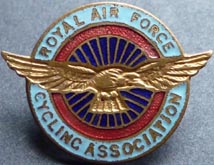
RAFCA (Royal Air Force Cycling Association)
In answer to another query, Derek Titchner replied:- I am not a great historian of the RAFCA but I will tell you what I know.
In 1952 through to 1954 I did my National Service in the RAF, during which time I cycled and raced in RAF Cycling Clubs which functioned under the RAFCA. This was a controlling body for all cycling activities within the RAF and went it’s own way independently of the civilian controlling organisations,the NCU and the RTTC both of whom were at war with the rebel road racing BLRC. In civilian circles a club joined one side or the other and if you were an NCU man and had the cheek to take part in a BLRC road race you were punished,sometimes with a life-time suspension. By the time I was called up I had left the NCU and joined the BLRC and found that once in the RAF I was free to race against all comers in all sorts of events,including Independents and Professionals. Some RAF clubs were very active, that at St. Athan promoted time trials, perimeter track circuit road races,and track racing on the Cardiff Commonwealth track. Every event was open to all comers, local club riders as well as RAF types. We were also encouraged to race in local civilian events as well as off-station Service races.
All under the aegis of the RAFCA and therefore free from penalty. It was thus I found myself entered (ordered more like!) in the RAF 5-day event (see Alan Colburn’s conribution below) of some 540 miles on open roads starting and stopping at RAF camps. Amongst other riders were Joe Christison, Fred Krebs, Tony Hoar, Ted Gerrard, Ron Coe, John Pound, John Chance and Johnny Brackstone, not to forget Gino Goddard. Thus you see belonging to the RAFCA was totally inclusive from amateur to hardened Pro.
As I recall the Chair of the RAFCA and quite possibly the driving force at that time was Squadron Leader Wooley, otherwise member of the Barnet CC and keen time triallist. The RAFCA continued for many years after this, but I cannot say if it still functions.
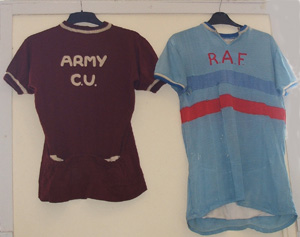
Alan Colburn remembers: Well – this subject has certainly got the memory cells banging about. I spoke on the phone last night with my old team mate, Derek Buttle, and he passed on some extra information which had been given to him by John Leech [?] He confirmed that the RAF 5-day event was 1951 and gave the stages involved:
1. Henlow to Cranwell
2. Cranwell to Newton to Bottesford [Two stages]
3. Bottesford to Cosford
4 Cosford to Innsworth.
5. Innsworth to Abingdon to Halton [Two stages]
I think I ‘ve got the stages correct – I know my contribution was curtailed at Innsworth !! So there we have it – It was a RAF Five Day Stage Race run on a Time Trial basis. A first for the RAF and I venture to suggest a first and unique event in the UK. Tough event but it was fun – what I mean is it was fun when you’re looking back sixty years !!
Ed: The RAFCA seems to have been superseded by RAF Cycling
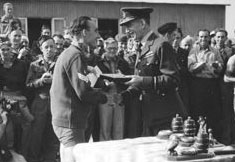
The Buckshee Wheelers
The man behind the Buckshee Wheelers was Johnnie Walker, a member of the Sheffield Central and Oval CC who was posted to Cairo in October 1939 as a sergeant in General Staff Intelligence. Like many servicemen he had left his bike back in the UK but managed to buy one in Egypt that he rode around Cairo when not on duty.
The upshot was that he met other cyclists in the area and together they advertised in the Egyptian Mail that they had a spare bike which servicemen could use when on leave. This resulted in some 180 letters from personnel wishing to go cycling again. Johnnie organised a cyclist reunion in Cairo which was attended by over a hundred military men keen to experience the fellowship of other cyclists’ company.
Thus was formed the Fraternity of the Buckshee Wheelers very soon known as just The Buckshee Wheelers. Buckshee was derived from baksheesh, an Arabic word denoting ‘free or something for nothing’. Now they had a club, hundreds of potential members but only four bikes so Johnnie appealed to the cycle trade back home in the UK who, to their amazement, shipped out 100 new bikes loaded onto three army lorries.
Now the club was established with machines they set about organising their first race in October 1941. It was a 25-mile time trial starting beneath the pyramids and the winner was presented with the ‘Bully Beef Trophy’, made by another soldier from a silver-plated bully-beef tin hammered into the shape of a pyramid and mounted on a wooden plinth. The club also ran regular club runs of up to 100 miles over the desert roads. The Bully Beef Trophy continued to be a success for several years until in 1944 the club decided to organise a massed-start road race on the island of Ghezira where several hundred police obligingly closed the roads for the event! An Egyptian, Faris Bey Sarafin, donated a magnificent 50 guinea cup for the event which had an entry of 120 riders.
By the end of the war in 1945 the Buckshee Wheelers had grown to 19 clubs. Their success story had encouraged the creation of other service-based clubs around the world including ‘The Jungle Roamers’ in Ceylon, ‘The Central Mediterranean Wheelers’ in Italy, ‘The Tropical Twiddlers’ in India, and the ‘Liberation CC’ in Europe. The RAF had their own club, The Exiles, and many inter-service events were held in Egypt. A track event at the famous Alamein Club attracted 15,000 spectators and the entry included servicemen and civilians from Egypt, Syria and Armenia.
When the war ended Buckshee Wheelers carried on back in the UK and held regular reunions and an annual time trial for the Bully Beef Trophy.
In 1945 Johnnie let it be known that he supported Percy Stallard and ‘The League’, thus being drawn into the peace-time hostilities between ‘The League’ and The Union’ which were almost as bitter as the war they had just fought in the desert.
Thanks to Tony Hewson (Tour of Britain winner and Tour de France rider) for allowing me to use images and information from the appropriate 16-page chapter in his book, A Racing Cyclist’s Worst Nightmare, available from Tony at £10 including UK postage. His website at: http://www.tonyhewson.co.uk/ has contact details.
Posted: Saturday 22nd August 2020
Contents
- Introduction
- Brent Jewish Road Club
- The National Clarion Cycling Club
- Primrose League Cycling Corps
- Romford Working Men's CC
- Rosslyn Ladies
- The Cyclist" Road Club
- The San Fairy Ann CC
- MTB Champion
- Spartacus CC
- Christopher Cycling Clubs
- Vegetarian Cycling And Athletic Club
- Gallery Of Badges
- Aerodyne Cycling
- Ericsson Wheelers
- Gaiety Cycling Club
- Crystal Palace Track
- The Theatrical United Cycling Club
- The Exiles
- Royal Air Force Cycling Association
- Gallery
- End Of The War
This article appears in the following categories.
Upcoming Events
Whether you are looking for a gentle social meet up, or a 100-mile ride browse the community’s upcoming events and plan your next weekend outing.
